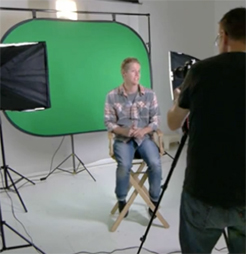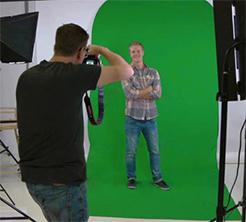
Equipment checkout in 213 Hale Library has added two large, portable green screens for K-Staters to check out. Each screen can be leaned against a wall or other support for videotaping, or users can check out a backdrop stand. LED lights, available from checkout, can be used to provide additional lighting.
The smaller screen, shown at right, is a 5-foot by 7-foot reversible green screen + blue screen. The larger green+blue screen, which is 7 foot wide by 9 foot high with a 7-foot deep floor overlay, is shown below.
These screens are used to make a background color (usually green or blue) transparent while another image layer “appears” in the backgound.

According to Wikipedia, chroma key compositing, also known as chroma keying, is “a special effects / post-production technique for compositing two images or video streams together based on color hues.”
The technique can be used to remove a background from the subject of a photo or video. The newscasting, motion picture, and videogame industries frequently use this technique.
It is commonly used for weather-forecast broadcasts, where a news presenter is seen standing in front of a large map during live television newscasts. In actuality, the presenter stands in front of a large blue or green background with the map superimposed on the background in post-production.
Software to do chroma key compositing is available on computers in the Media Development Center, 213 Hale Library.